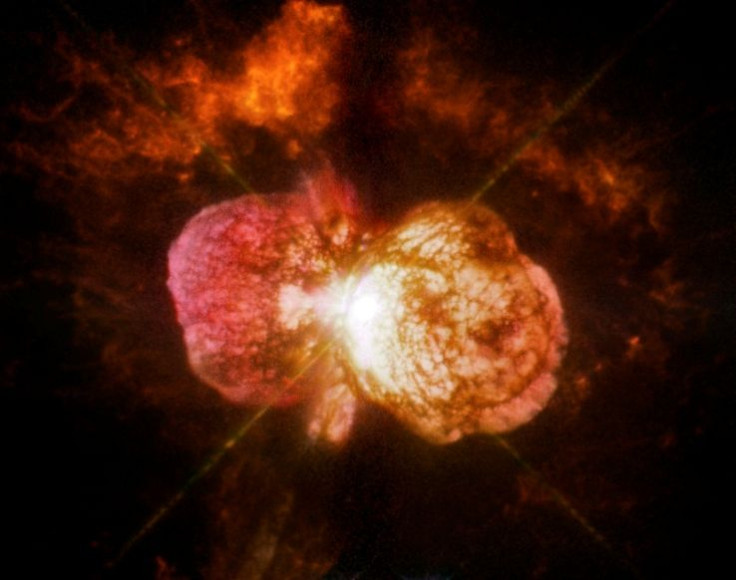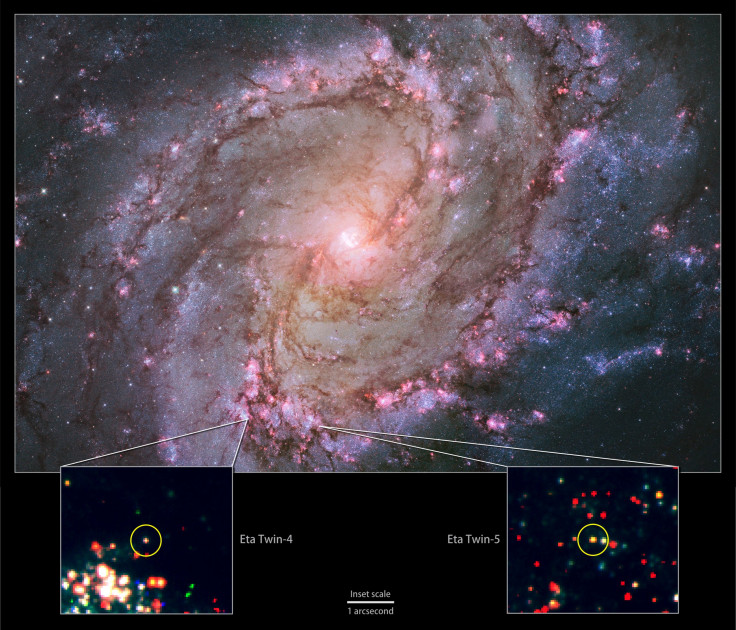Eta Carinae ‘Twins’ Discovered In Neighboring Galaxies

In the summer of 1843, star-gazers were able to glimpse a new star in the night sky, albeit briefly. Between March 11 and March 14 of the year, Eta Carinae -- a binary star system located 7,500 light-years away and consisting of two massive stars locked tight in a 5.5-year orbit -- became the second brightest star in the sky, before fading well below naked eye visibility.
Eta Carinae’s most distinctive feature is a massive envelope of gas and dust, produced as a result of a massive eruption in the 1840s that spewed the equivalent of more than 10 times the mass of our sun into space. Tantalizingly, astronomers cannot yet explain what caused this eruption.
Scientists have long wondered if this star system is one of a kind, as decades of searches yielded nothing like it in our galaxy or beyond. Now, a new study, which utilizes archival data from NASA's Spitzer and Hubble space telescopes, finally answers the question.
NASA announced Wednesday that five “twins” of the star system in nearby galaxies have been discovered. These five objects mimic the optical and infrared properties of Eta Carinae, indicating that each of them very likely contains masssive star buried in five to 10 solar masses of gas and dust.

The discovery of these twins -- two in the galaxy M83, located about 15 million light years away, and one each in NGC 6946, M101, and M51, located between 18 million and 26 million light-years away -- is likely to help scientists better understand the birth, evolution and death of massive stars.
“We knew others were out there,” co-investigator Krzysztof Stanek, a professor of astronomy at Ohio State University in Columbus, said, in a statement released Wednesday. “It was really a matter of figuring out what to look for and of being persistent.”
Eta Carinae outshines our sun by 5 million times. Astronomers estimate that the more massive star has about 90 times our sun’s mass, while the smaller companion may exceed 30 solar masses.
So, what makes a star system like Eta Carina such a rarity?
As NASA explains, catching such star systems during the short-lived aftermath of a major outburst “approaches needle-and-haystack levels of difficulty.” Prior to the latest discoveries, surveys of seven galaxies between 2012 and 2014 failed to turn up any Eta twins, further underscoring their rarity.
“Eta Carinae is not unique ... It happens in nature,” lead scientist Rubab Khan, a postdoctoral researcher at NASA's Goddard Space Flight Center in Greenbelt, Maryland, reportedly said. “However, it’s very, very rare. This is the first time we can quantitatively say just how rare Eta Carinae is.”
© Copyright IBTimes 2024. All rights reserved.





















